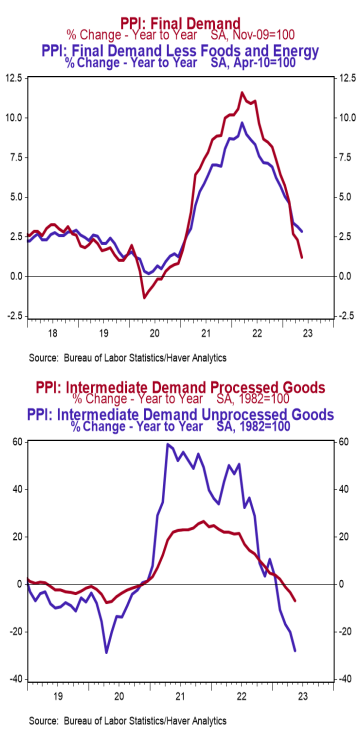- The Producer Price Index (PPI) declined 0.3% in May, coming in below the consensus expected -0.1%. Producer prices are up 1.1% versus a year ago.
- Energy prices declined 6.8% in May, while food prices declined 1.3%. Producer prices excluding food and energy rose 0.2% in May and are up 2.8% versus a year ago.
- In the past year, prices for goods are down 2.4%, while prices for services have risen 2.7%. Private capital equipment prices rose 0.5% in May and are up 3.6% in the past year.
- Prices for intermediate processed goods fell 1.5% in May and are down 7.1% versus a year ago. Prices for intermediate unprocessed goods declined 4.8% in May and are down 27.5% versus a year ago.
Implications:
Producer prices declined for the third time in four months, falling 0.3% in May. As you can see from the nearby chart, the year-ago comparison for producer prices, now up 1.1%, has been moderating since the 11.7% peak in March 2022. Keep in mind, though, that part of the moderation is due to outsized jumps in inflation immediately after the invasion of Ukraine last year, which are now rolling off year-ago calculations. Taking a look at the details of today’s report shows that “core” prices – which excludes the typically volatile food and energy components – rose 0.2% in May and are up 2.8% in the past year. The services sector led prices higher in May, rising 0.2%. Meanwhile, goods prices fell 1.6% in May, led by a 13.8% decline in the costs for gasoline. Prices further back in the pipeline were decidedly lower, as prices for intermediate demand processed goods fell 1.5% in May while unprocessed goods dropped 4.8% and are down 27.5% in the past year. While some good news on inflation is welcome, data from yesterday’s CPI report shows the Fed’s job is not yet over. We expect the Fed to stand pat on rates today, but another 25 basis point rate hike in July is possible and is currently being (mostly) priced in by the futures market in federal funds. The economy is in the grips of a battle between the ongoing impacts from the tsunami of money that hit the system in 2020-2021 and is still being absorbed, while at the same time starting to show signs of the riptide from the Fed and Treasury Department now pulling money out of the system. Manufacturing activity has clearly slowed, jobs continue to rise but gains have been offset by a slowdown in hours worked, and retail sales are down in the past year when adjusted for inflation. Economic growth remains modestly positive, but a recession looks likely in the not-too-distant future. How the Fed will respond if/when a recession appears is very much an open question. The Fed’s failures in the 1970s should be a stark reminder of the painful results of easing before the battle against inflation is fully won.





